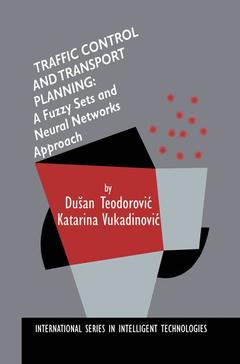Traffic Control and Transport Planning:, 1998 A Fuzzy Sets and Neural Networks Approach Coll. International Series in Intelligent Technologies, Vol. 13
Langue : Français

When solving real-life engineering problems, linguistic information is often encountered that is frequently hard to quantify using "classical" mathematical techniques. This linguistic information represents subjective knowledge. Through the assumptions made by the analyst when forming the mathematical model, the linguistic information is often ignored. On the other hand, a wide range of traffic and transportation engineering parameters are characterized by uncertainty, subjectivity, imprecision, and ambiguity. Human operators, dispatchers, drivers, and passengers use this subjective knowledge or linguistic information on a daily basis when making decisions. Decisions about route choice, mode of transportation, most suitable departure time, or dispatching trucks are made by drivers, passengers, or dispatchers. In each case the decision maker is a human. The environment in which a human expert (human controller) makes decisions is most often complex, making it difficult to formulate a suitable mathematical model. Thus, the development of fuzzy logic systems seems justified in such situations. In certain situations we accept linguistic information much more easily than numerical information. In the same vein, we are perfectly capable of accepting approximate numerical values and making decisions based on them. In a great number of cases we use approximate numerical values exclusively. It should be emphasized that the subjective estimates of different traffic parameters differs from dispatcher to dispatcher, driver to driver, and passenger to passenger.
1. Basic Definitions of The Fuzzy Sets Theory.- 1.1. The Concept of Fuzzy Sets.- 1.2. The Equality of Fuzzy Sets.- 1.3. Subsets of Fuzzy Sets.- 1.4. The Intersection of Fuzzy Sets.- 1.5. The Union of Fuzzy Sets.- 1.6. Fuzzy Set Height.- 1.7. Support of Fuzzy Set.- 1.8. The Scalar Cardinality of Fuzzy Set.- 1.9. Complement of Fuzzy Sets.- 1.10. Convex Fuzzy Sets.- 1.11. Linguistic Hedges.- 1.12. Fuzzy Sets as Points in Hypercubes.- 1.13. Fuzzy Relations.- 1.14. Max-min Composition.- 1.15. Extension Principle.- 1.16. Alpha Cut.- 1.17. The Concept ot a Fuzzy Number.- 1.18. Adding Fuzzy Numbers.- 1.19. Subtracting Fuzzy Numbers.- 1.20. Multiplying and Dividing Fuzzy Numbers.- 1.21. Multiplying a Fuzzy Number by a Constant.- 1.22. Triangular and Trapezoidal Fuzzy Numbers.- 1.23. Kaufmann and Gupta’s Method for Comparing Fuzzy Numbers.- 1.24. The Basic Elements of Fuzzy Systems 56 1.24.1. Graphical interpretation of fuzzy logic inference.- 2. Presentation of Fuzzy Models Developed in Transportation Applications.- 2.1. Vehicle Routing Model Based on the Rules of Fuzzy Arithmetic.- 2.2. Scheduling Algorithm for a Static Dial-a-ride Problem Based on Fuzzy Arithmetic Rules.- 2.3. Fuzzy Multiple-attribute Decision Making: The Choice of the Best Alternative for Organizing Air Shuttle Service.- 2.4. Controlling an Isolated Signalized Intersection Using Fuzzy Logic.- 2.5. A Fuzzy Traffic Control System on an Urban Expressway.- 2.6. Solving the Route-choice Problems in Urban Networks Using Fuzzy Logic.- 2.7. Modeling Route Choice with Advanced Traveler Information by Fuzzy Logic.- 2.8. Approximate Reasoning Route-choice Model on an Airline Network.- 2.9. A Fuzzy Logic Approach to the Vehicle Routing Problem when Demand at Nodes Is Uncertain.- 2.10. Air Traffic Flow Management ModelBased on Fuzzy Logic.- 2.11. Controlling a Fleet in River Traffic Using Fuzzy Logic.- 2.12. A Fuzzy Logic Approach to the Aircrew Rostering Problem.- 2.13. A Fuzzy Logic Approach to the Vehicle Assignment Problem.- 3. A Fuzzy Mathematical Programming Approach to Transportation.- 3.1. The Basic Premises of Fuzzy Mathematical Programming.- 3.2. Fuzzy Linear Programming.- 3.3. Solving a Fuzzy Linear Programming Problem when Constraint Coefficients Are Fuzzy.- 3.4. Solving a Fuzzy Linear Programming Problem when Objective Function Coefficients Are Fuzzy.- 3.5. Solving a Fuzzy Linear Programming Problem when the Constraints Are Fuzzy.- 3.6. Airline Network Design by Fuzzy Linear Programming.- 3.7. Airline Network Seat Inventory Control: a Fuzzy Mathematical Programming Approach.- 4. Applications of Artificial Neural Networks in Transportation.- 4.1. Basic Concepts of Artificial Neural Networks.- 4.2. Transportation Demand Forecasting with Neural Network Models.- 4.3. Backpropagation Neural Network for Estimation of an Origin-destination Matrix.- 4.4. Backpropagation Neural Network for Estimating a Real-time Origin-destination Matrix from Traffic Counts.- 4.5. Neural Network Approach to Transportation Network Improvement Problem.- 4.6. Routing and Scheduling Algorithm for the Dynamic Dial-a-ride Problem Based on Neural Networks.- 4.7. A Neural Network Approach to Mitigation of Vehicle Schedule Disturbances.- 4.8. A Neural Network Approach to Vessel Dispatching Problem.- 5. Generating and Tuning The Fuzzy Logic Systems Developed in Transportation Applications.- 5.1. Membership Functions Design.- 5.2. Membership Value Assignment Process Based on Intuition.- 5.3. Membership Value Assignment Process Based on Facts and Knowledge.- 5.4. Membership Value Assignments as a Combinatorial Optimization Problem.- 5.5. Method To Generate Fuzzy Rules from Numerical and Linguistic Information.- 5.6. Simultaneous Design of Membership Functions and Fuzzy Rules from Numerical Information by Genetic Algorithms.- 5.7. An Application of Neurofuzzy Modeling: The Vehicle Assignment Problem.- References.
Date de parution : 10-2012
Ouvrage de 387 p.
15.5x23.5 cm
Thèmes de Traffic Control and Transport Planning: :
© 2024 LAVOISIER S.A.S.



